A Guide to Understand Life Cycle of Butterfly with Diagram
As an insect, butterflies have life cycles separated in several stages. They hatch from eggs and get out from there as caterpillars and emerge into pretty butterflies. This long process is called metamorphosis. To understand the process, the students must have a thorough idea about the butterfly life cycle. For learning the life cycle of a butterfly, the students must use a life cycle of a butterfly diagram. However, creating a life cycle of a butterfly diagram is not very easy, and the students may fail to generate a good result. Therefore, they must use the EdrawMax Online tool.
1. The Life Cycle of Butterfly
For a butterfly to reach its adult stage from egg and complete the process of metamorphosis, it needs to undergo a total of four steps. The steps of the life cycle of a butterfly are distinct, and they have different goals. Here is a discussion about the four stages of the life cycle of a butterfly.
Let us explore the life cycle of a butterfly in detail, including all four stages of life. Adults go through four stages: eggs, larvae, pupae and adults. Each stage has different goals. For example, caterpillars need to eat a lot, and adults need to reproduce. Depending on the type of butterfly, the life cycle of a butterfly may take from one month to a whole year. You can print this butterfly life cycle coloring page so that we can discuss the 4 stages.
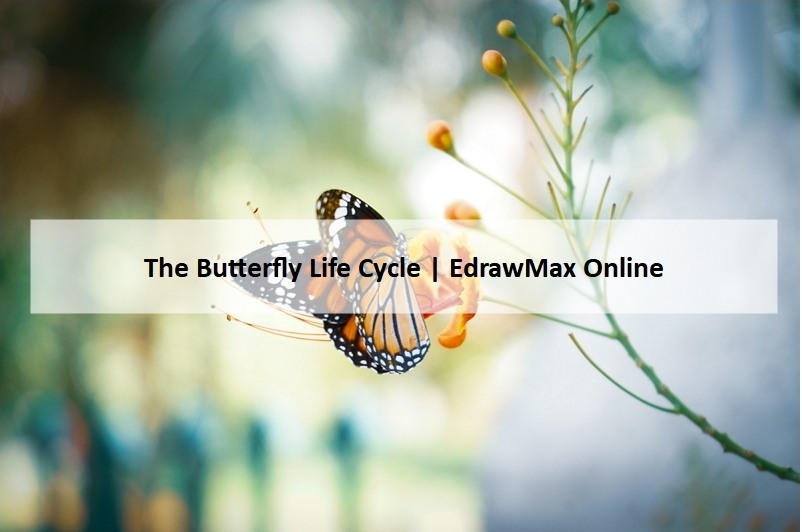
Stage 1: The Egg
The first stage of the life cycle of a butterfly is the egg. The butterflies lay their eggs under the leaves, and they are mainly small in size. The eggs can be round, oval, or cylindrical shaped. In the case of Monarch butterflies, one can see the tiny caterpillars growing inside the eggs. The eggs may be smooth or wrinkled, the size and shape of the species of the butterfly. The eggs can hatch within a few weeks or may need some warmth to hatch.
Stage 2: Caterpillar
The larva stage of the butterfly is called the caterpillar. When the eggs hatch, the caterpillars come out, and they only eat leaves throughout this period. This period is not prolonged. The mother butterflies lay eggs on the leaves which their species eat because as soon as the caterpillars come out, they start chewing on the leaves, where the eggs were hatched. As the caterpillars grow by ‘molting,' they shed their skin four to five times. If compared, the full-grown caterpillars can be 100 times bigger than the newly-hatched caterpillars.
Stage 3: Pupa
When a caterpillar attains its complete growth, it forms a vessel-like structure around itself, called pupa or chrysalis. Inside the pupa, the caterpillar undergoes a metamorphosis. From the pupa, the caterpillar’s body organs, tissues also change to emerge as a butterfly. These pupa's formation occurs on a twig in a hidden place. The outer cover is solid as it protects them from predators and unfavorable weather conditions. This stage may last for months before the caterpillar emerges from the pupa as a beautiful butterfly.
Stage 4: Adult
When a butterfly has entirely attained its changes, they gradually rip open the pupa. But, to fly away takes some time (generally 4-5 hours). Their wings are wet and wrinkled as they stay wrapped around their body in the pupa to fit the whole thing within that small vessel-like structure. As the wings dry, the butterflies pump hemolymph liquid to their wings to make them stronger. They also require blood to be pumped to their wings to make them fit for a flight. Once they are ready with strong wings, the butterflies fly away in search of flowers for food.
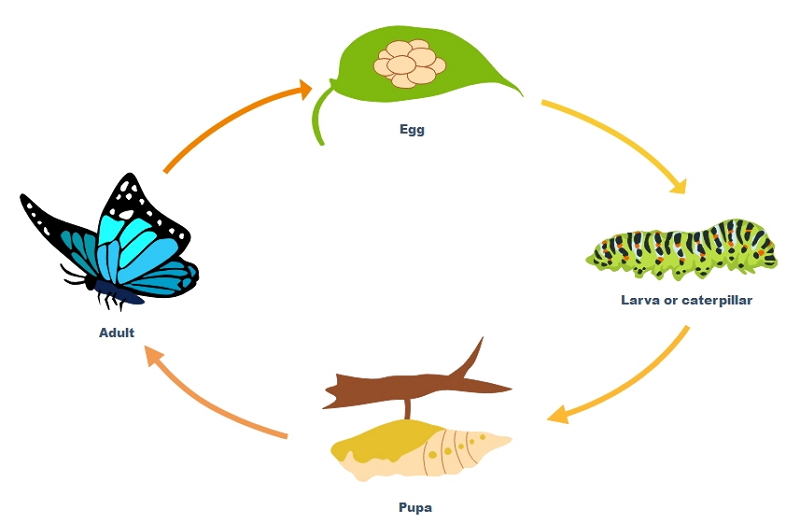 Source:EdrawMax Online
Source:EdrawMax Online
The adult butterflies then search for mates and lay eggs on the leaves, and the whole butterfly life cycle starts again.
3. How to Draw the Life Cycle of Butterfly Diagram
To understand the process of metamorphosis, the students must learn the life cycle of a butterfly. For that, the students must use the life cycle of butterfly diagrams. However, drawing this by hand is lengthy, and properly creating all four stages is tough. The students can follow the following steps to create a life cycle of butterfly diagram:
3.1 How to Create Life Cycle of Butterfly Diagram from Sketch
Creating such a diagram by hand can be difficult. The students can follow these steps to make their elbow joint diagram:
Step 1: The students need to draw a big circle and separate it into five sections. On the topmost section of the circle, they have to draw a butterfly. They have to draw a rod-like structure with a pointed end and a small circular head on top of it. After that, the students should draw the four wings with two on both sides. The upper wings are bigger than the others. They need to put two suckers on top of their head.
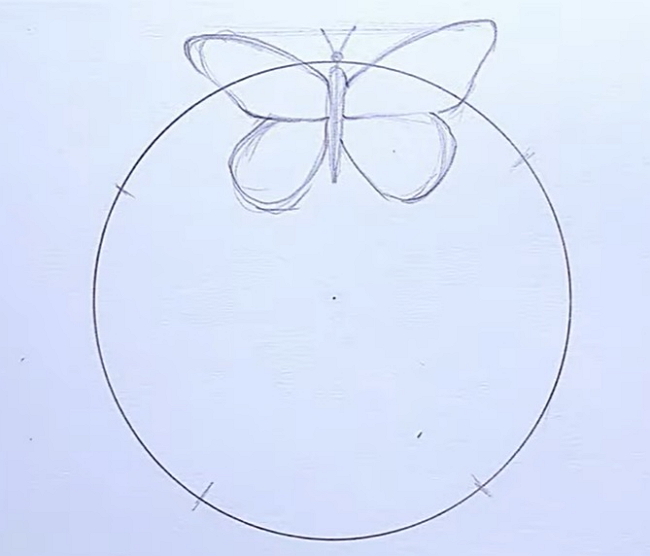
Step 2: Now the students should draw the arrows from the butterfly head to the eggs. They need to draw a leaf first and then draw a small circular or oval-shaped figure or the butterfly egg.
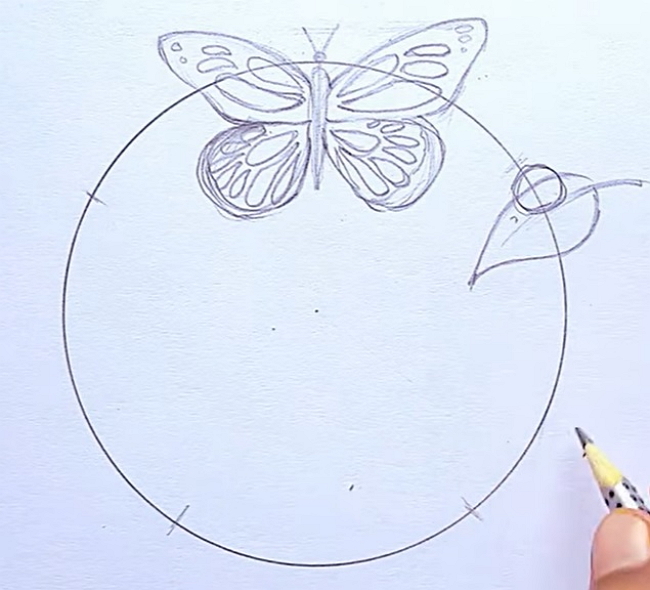
Step 3: The next part of the life cycle of a butterfly is caterpillars, and to draw caterpillars, the students need to draw a worm-like shape with multiple legs and strokes on their back. They have to create the caterpillar on a leaf.
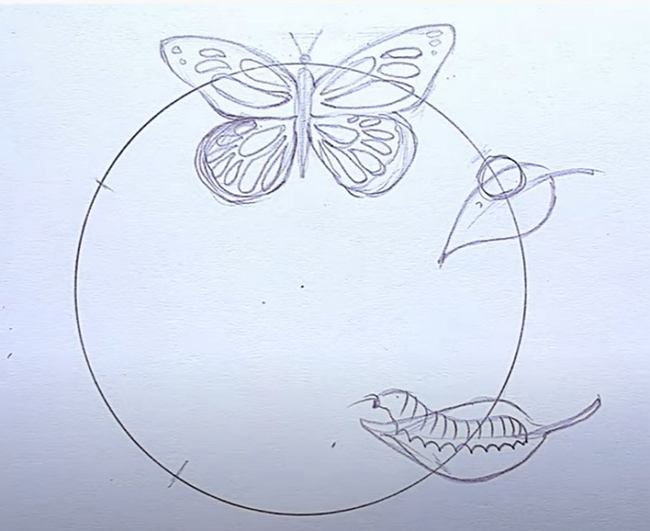
Step 4: The fourth section will show the pupa stage. Hence, the students should draw a vessel-like structure with two overlapping semi-circular features at the bottom. The vessel will be hanging from a twig with leaves to indicate its place.
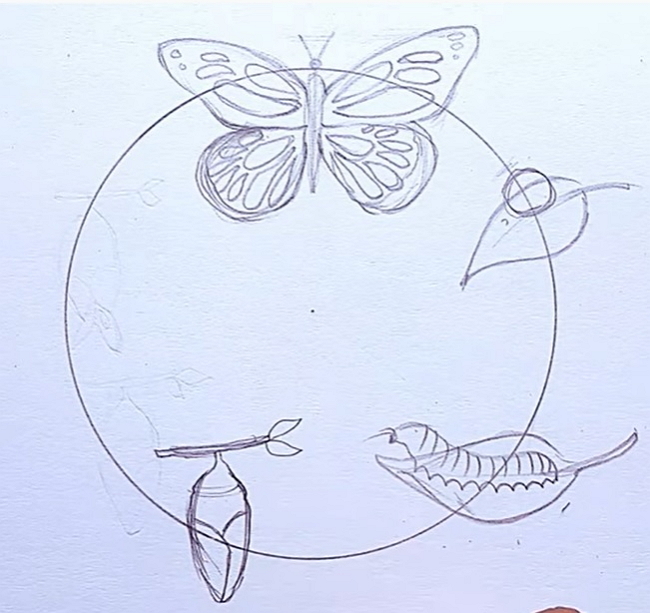
Step 5: For the next stage of the butterfly life cycle, the students need to draw a similar figure that they have drawn for the pupa. But, for this stage, they need to show the wings coming out the end of the pupa. Finally, these stages are joined with arrows to indicate the paths of the life cycle of a butterfly.
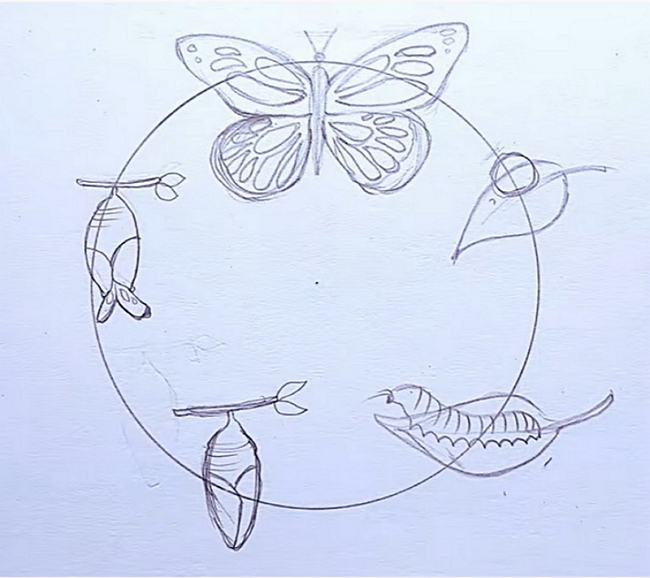
3.2 How to Create Life Cycle of Butterfly Diagram Online
It is challenging to create this diagram by hand. The students may not get a good result. Hence, the students must use the user-friendly EdrawMax Online tool. They can make the life cycle of butterflies effortlessly, and for that, they need to follow these simple steps:
Step 1: EdrawMax Online is an easy-to-use tool, and hence the students can create a high-quality diagram without much hassle. To start with the process, they need to open the EdrawMax Online and then open New. Under this part, they can find the Science and Education tab. There are several types of diagrams that the students can use for learning.

Step 2: They can select the Biology option. It has a wide range of high-quality diagrams related to the subject. The students can choose the life cycle of a butterfly. After selecting, they can modify the images as per their requirements. It can help them create a perfect high-quality picture that they can utilize for their lessons or school projects.
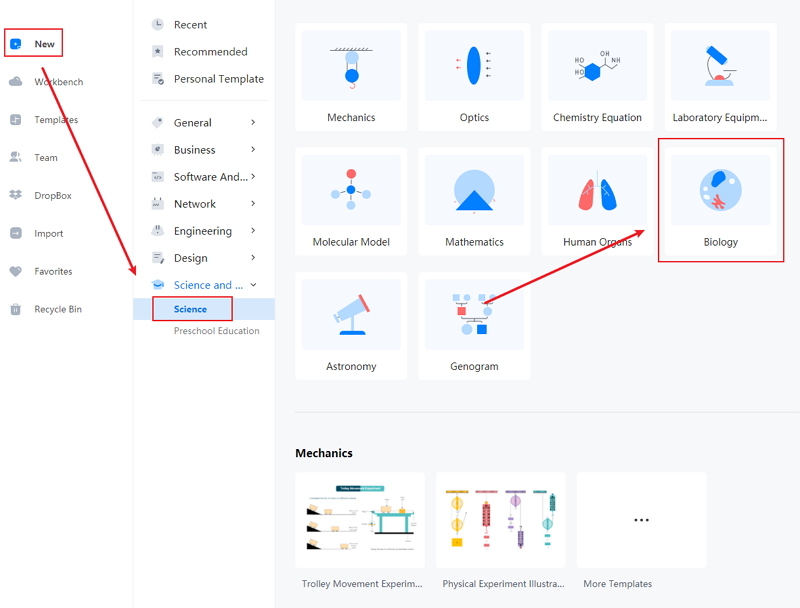
Step 3: After selecting the template they require, the students should modify it as per their choice. The tool gives the students some hassle-free options to edit their diagrams. They can work on those images according to their preference to create a high-quality life cycle of a butterfly image.
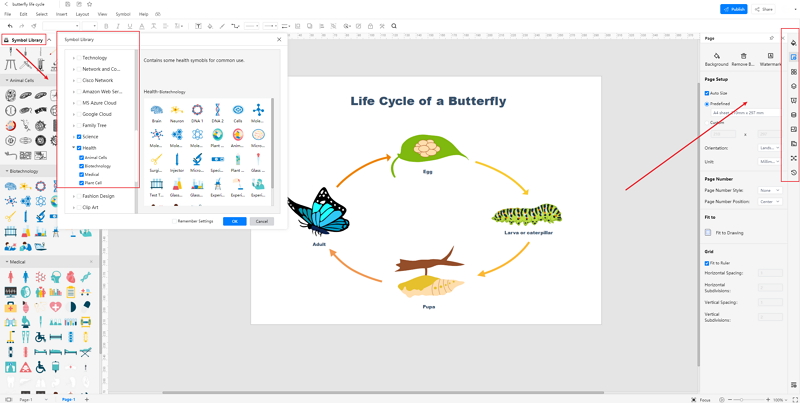
Step 4: Once they have finished the editing, they can save the diagram in multiple formats. They can also export it and use it in their projects and dissertation papers.
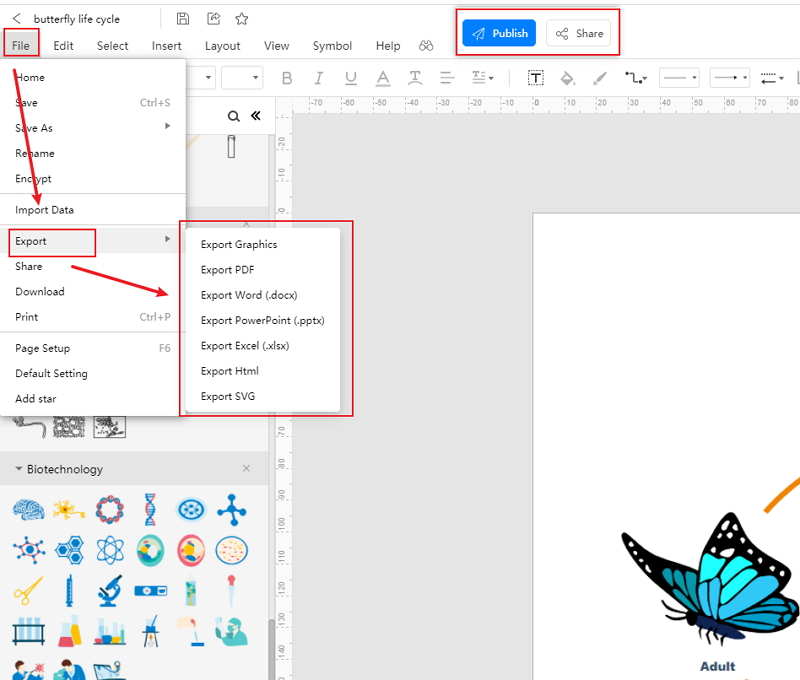
4. How to See the Butterfly Life Cycle
The butterflies mainly lay eggs in hidden places, and it is rare to see the complete butterfly life cycle in their normal habitat. Hence, students can look for live butterfly kits or butterfly raising kits. They are good media to learn about the life cycle of a butterfly. They are also fit for science projects. They can see the eggs hatching with the whole four stages. They can also observe the caterpillar getting transformed into a mature butterfly.
The students can observe and note the whole incident and note the behavior of the subject stage. They can also release the butterflies to live their life and search for food and mate. If kids are involved in it, releasing the butterfly can be a lesson for them. They may learn not to cage an animal and let them live in their natural habitat.
5. Conclusion
The life cycle of a butterfly shows how the complete transition changes the caterpillar into a butterfly. The mechanism occurs in a cycle as the mature butterfly searches for its mate. The students can use diagrams to learn the complex changes which a butterfly undergoes in its life cycle. Since the process can be challenging, especially while creating the image by hand, they must use the EdrawMax Online tool. The tool can help them to create a high-quality diagram without much hassle.
In conclusion, EdrawMax Online is a quick-start diagramming tool, which is easier to make artery and vein diagram and any 280 types of diagrams. Also, it contains substantial built-in templates that you can use for free, or share your science diagrams with others in our template community.




